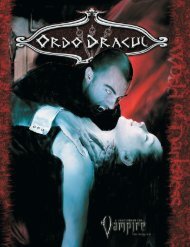Mind's Eye Theatre - Vampire The Requiem.pdf - RoseRed
Mind's Eye Theatre - Vampire The Requiem.pdf - RoseRed
Mind's Eye Theatre - Vampire The Requiem.pdf - RoseRed
Create successful ePaper yourself
Turn your PDF publications into a flip-book with our unique Google optimized e-Paper software.
In addition to the categories presented in Mind’s <strong>Eye</strong> <strong><strong>The</strong>atre</strong>, you may wish to<br />
add or replace some Kindred-specifi c categories such as: “<strong>The</strong> Struggle Against the<br />
Beast,” “Internal City Politics” and “Vampiric History.” Another category that might<br />
deserve special addition for <strong>Requiem</strong> chronicles (and perhaps Mind’s <strong>Eye</strong> <strong><strong>The</strong>atre</strong><br />
in general) is “Player vs. Player.” Quite simply, some players love competing against<br />
their friends in a game environment, while others would rather focus on external<br />
threats and battling Narrator characters instead. <strong>The</strong> <strong>Requiem</strong> can easily become<br />
extremely cutthroat in ways that some players love but others fi nd uncomfortable,<br />
so don’t underestimate the importance of this question. If a lot of the players enjoy<br />
being pitted against each other, they’re likely to be fi ne with a chronicle that revolves<br />
around wresting control of the city from other players. If most of the players would<br />
rather go up against Narrator characters, you could run the same story and simply<br />
put all the players on the same side against a Narrator faction.<br />
If your players have previous knowledge of <strong>The</strong> <strong>Requiem</strong> you might inquire as to<br />
which clans, covenants and political factions appeal to them the most (and least). Cover<br />
some of the themes that go along with <strong>The</strong> <strong>Requiem</strong>, perhaps asking players to choose<br />
one or two they’d like to see the most. Also, a player survey is an excellent place to<br />
put a space for players to list any kinds of topics or stories they fi nd uncomfortable<br />
or objectionable.<br />
Remember, this isn’t an examination to get into a university, but rather a poll of<br />
your player’s interests in regards to the Danse Macabre. Keep your list of questions<br />
short, but urge your players to take your survey seriously. After all, this is helping to<br />
personalize the game to best entertain them. It’s in their best interests to be forthright<br />
and thoughtful.<br />
Also, another consideration to keep in mind in the early planning stage is how long a<br />
chronicle you and your players want. A short chronicle of four to six episodes demands quite<br />
different planning than a chronicle meant to continue indefi nitely, through dozens of sessions<br />
and multiple story arcs. In a story with a prior set limited running time, the players might try<br />
to give their characters every trait, Merit and personality quirk right away since the chronicle<br />
won’t have many opportunities to grow and change. On the other hand, players might generate<br />
more singularly focused characters, with less attention paid to their chances of surviving<br />
a long chronicle. As a Storyteller, meanwhile, you need to devise plots with clearly defi ned<br />
endings. While some loose ends might exist, your own characters and story elements need to<br />
make an impression quickly. <strong>The</strong>y might not be on your imaginary stage very long.<br />
Once you have some idea of what sort of chronicle you plan to run, you can fl esh out<br />
vague notions into characters, a setting, plots, a theme and other details. Remember, if you<br />
are planning on maintaining a staff of Narrators and Assistant Storytellers, seek their input<br />
in this process. Different perspectives are extremely useful in plotting out a long running<br />
story that will maintain the interest of its players.<br />
You might start with a particular theme, and choose plots to illustrate it; you might begin<br />
with a character or set of characters, and build the chronicle around them. Sometimes it’s<br />
best to simply start with a strong visual image that captures the essence of what you want your<br />
story to be about: A vampiric lord of a city whose normally casual demeanor begins showing<br />
signs of a growing insanity. A circle of malcontents meeting and conspiring in hushed tones<br />
in a crowded bar surrounded by unsuspecting mortals. A revel of the undead — showcasing<br />
the contrast of the twisted hypocrisy of displaying polite behavior among blood thirsty monsters.<br />
Don’t be too quick to settle on just one idea, either. A good method of helping plot<br />
out events is to just jot down ideas as your fancy wanders, and look for connections between<br />
them. Brainstorm with a list of images that best refl ect what you want to see in your story.<br />
Eventually, bits of inspiration will coalesce and you will know what your chronicle is about.<br />
300<br />
mind’s chapter eye four: theatre: storytelling requiem



